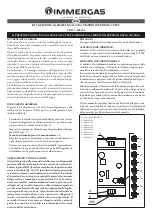
16
8.
Joining and Sealing the Vent Pipe:
The vent pipe needs to be both watertight and gas
tight. Seal all joints and seams as follows:
A. For Z-Flex Z-Vent stainless steel vent pipe use
a high temperature silicone sealant rated for
550°F. The outside of the male end and inside
of the female end of the pipe must be cleaned
with brake cleaner before applying silicone bead.
For 3” vent pipe runs begin with the male end
of the vent pipe over the boilers induced draft
blower outlet. For 4” vent pipe runs begin with a
6” length of 3” Z-Vent over the boiler’s induced
draft blower outlet, to which an even bead of high
temperature silicone sealant should be applied.
Then connect the 3” Z-Vent to a Z-Vent 3” to 4”
reducer. Then continue the 4” Z-Vent pipe run by
connecting the 4” male end of the Z-Vent to the
reducer. (A locking band may be used around this
joint for additional support.) Then following the
sealing instructions, push the 4” male end of the
Z-Vent over the 4” increaser
fi
tting. When using
the Tjernlund VH-1 vent hood, the female end
(
fl
ared end) of the vent pipe will be connected to
the termination hood. The male end of the vent
hood must be crimped before pushing the Z-Vent
over the vent hood’s connecting pipe. Before the
pipes are joined, apply a ¼” bead of silicone one
inch from the end of the male end. Then push the
pipes together as far as they will go making sure
any seams are aligned and oriented upward. Now
apply another bead of silicone around this joint and
smooth out. Then use a Z-Flex locking band around
the center of the joint.
1. Apply the high temperature silicone
approximately one inch from the end, around
the male end of the pipe in an even ¼” bead.
2. Pipes can now be pushed together as far as they
will go. The seams on pipe should be aligned
and oriented upward in all horizontal appliances.
Apply another bead of silicone around this joint
and smooth out.
3. Slide locking band over center of joint and
tighten gear clamps. Make sure locking band is
centered on joint.
4. Check all joints and seams for gas tightness.
5. Horizontal venting shall have slope not less
than ¼” every 12 inches (21mm/m) downward
away from the boiler to prevent collection of
condensate throughout the assembly.
6. Allow sealant to cure for 24 hours before
operating appliance.
B. For Heat-Fab Saf-T-Vent stainless steel vent pipe
use a high temperature silicone sealant rated for
550°F The outside of the male end and inside
of the female end of the pipe must be cleaned
before applying the silicone bead. For 3” vent
pipe runs, the male end of the vent pipe which
goes over the outlet of the boiler’s induced draft
blower must be crimped. The vent pipe should be
crimped as minimal as possible to provide a tight
fi
t over the outlet. After crimping is completed fol-
low the instructions for applying silicone sealant.
For 4” vent pipe runs, begin with a Saf-T-Vent 3”
to 4” increaser
fi
tting over the boiler’s induced
draft blower outlet, to which an even bead of high
temperature silicone sealant should be applied.
Then continue the 4” Saf-T-Vent pipe run by con-
necting the 4” male end of the Saf-T-Vent to the
increaser. (A locking band may be used around this
joint for additional support.) The vent
fl
ow must be
in the direction indicated on the vent pipe. When
using the Tjernlund VH-1 vent hood, the female
end (
fl
ared end) of the vent pipe will be connected
to the termination hood. Apply high temperature
silicone in an even ¼” bead approximately ¼” to
⅜
” from the end of the vent hood’s connecting
vent pipe. Also, run a similar size bead of silicone
sealant down the seam weld of the vent pipe. Then
push the female end over the vent hood’s connect-
ing vent pipe.
1. Apply the high temperature silicone around
the male end of the pipe (without the tabs)
in an even ¼” bead. Silicone bead should be
approximately ¼” to
⅜
” from the end of the
male end. Also, run a similar size bead of
silicone sealant down the seam weld at the end
of each joint.
2. Pipes can now be pushed together as far as they
will go. The seams on the vent pipe should be
aligned and oriented upward in all horizontal
appliances. With a moistened
fi
nger or
fl
at tool,
spread any sealant that squeezes out around the
circumference of the joint.
3. Attach the sections together with the locking
rings and tabs (except at the blower outlet
where no locking ring exists.) Inspect the
joint to ensure that
fl
ue gases will not leak. If
necessary apply additional sealant around the
joint.
4. Horizontal venting shall have a slope not less
than ¼” every 12 inches (21mm/m) downward
away from the boiler to prevent collection of
condensate throughout the assembly.
5. Allow the sealant to cure for 24 hours before
operating the appliance.
HORIZONTAL VENTING INSTRUCTIONS
















































